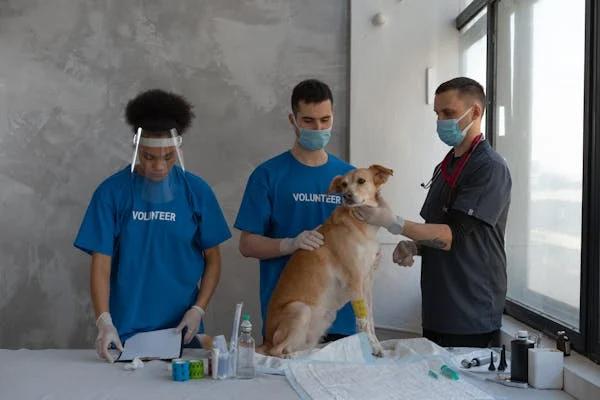What You Need to Know About Pet First Aid
- 13 February 2024
- BuyAPet Editorial Team
- All Cats, All Dogs, Cats and Dogs
What You Need to Know About Pet First Aid
Emergencies happen. Knowing the basics—from CPR to wound care—can keep your pet stable until you reach a vet. Use this friendly, practical guide to prepare.
The Importance of Pet First Aid
Stabilise before the vet
First aid can control bleeding, support breathing, and prevent shock—buying crucial time on the way to professional care.
Reduce pain & complications
Quick, calm actions minimise suffering and can keep minor issues from becoming life-threatening.
Common Pet Emergencies
Small toys/food can obstruct airways. Learn safe airway checks and pet Heimlich variations.
Apply firm pressure with clean gauze; elevate limb if safe. Bandage and monitor.
Household chemicals, meds, plants. Call a vet/poison line immediately—don’t induce vomiting unless told.
Immobilise with a padded splint; restrict movement; transport carefully.
Excess panting, collapse, bright red gums. Move to shade, cool with tepid water (not ice), seek vet care.
Time it, clear hazards, don’t restrain or put items in mouth; call your vet.
Note: species and breed differences exist—ask your vet for tailored advice.
Creating a Pet First Aid Kit
Basics
- Adhesive bandages, gauze pads & rolls
- Antiseptic wipes/solution; sterile saline
- Tweezers/forceps, blunt scissors, tick tool
- Digital thermometer, lubricant, disposable gloves
Medications & info
- Hydrogen peroxide (only if instructed by a vet)
- Antihistamine (dose per your vet)
- Any prescriptions your pet needs
- Vet/emergency numbers, poison hotline, vaccine record
Review your kit every 6 months and replace expired items.
Basic First Aid Techniques
CPR (dogs & cats)
For pets not breathing / no pulse. Technique varies by size/chest shape. Practice in a certified course for safe, effective compressions and breaths.
Wound care
Control bleeding with pressure, flush with saline, apply sterile dressing. Muzzle if needed to prevent defensive bites.
Splinting
Pad and immobilise joints above/below the suspected fracture. Transport gently; radiographs will confirm at the clinic.
Heat & cold therapy
Cold packs within 24–48h for swelling; warm compresses for stiffness—use cloth barriers and vet guidance.
Recognising Distress or Illness
Red flags
- Lethargy, collapse, unresponsive
- Laboured breathing, blue/grey gums
- Persistent vomiting/diarrhoea, blood in stool/urine
- Severe pain, bloated abdomen
Subtle changes
- Loss of appetite or sudden weight change
- Excess water intake or urination
- New aggression, hiding, restlessness
- Excess scratching/licking, lameness
If an Emergency Happens
- Assess & protect: Keep yourself and others safe; move the pet from danger.
- Stabilise: Airway, breathing, circulation; control bleeding; keep warm.
- Call a vet: Describe signs, weight, toxins involved, and first aid already given.
- Transport safely: Carrier or improvised stretcher; minimise movement.
- Hand-over: Provide timelines, meds, and any labels from ingested items.
Training & Helpful Resources
Get certified
Enroll in a recognised pet first aid/CPR class through local veterinary clinics or animal-care organisations to build muscle-memory and confidence.
Pocket references
Keep vetted (pun intended) guides or a reputable first-aid app on your phone for quick step-by-steps when seconds count.
Preventative Safety Checklist
Secure trash, meds, cleaners, cords, and toxic foods/plants.
Use leads/fences outdoors; watch water play and heat.
Balanced diet, exercise, parasite prevention, routine exams.
Stay current per your vet’s schedule.
Collar tags + registered microchip for quick reunions.
Audit first aid supplies every 6 months.
Be your pet’s first responder
Download a printable pet first aid checklist
Keep it on the fridge and in your travel kit. Share with sitters and family.
FAQs
What should be in a basic pet first aid kit?
Gauze, bandages, antiseptic, saline, tweezers, scissors, tick tool, thermometer, gloves, vet/emergency numbers, and any prescriptions your pet needs.
Should I ever induce vomiting after poisoning?
Only if a veterinarian or poison hotline tells you to. Some substances (e.g., caustics, hydrocarbons) make vomiting dangerous.
How do I check a pet’s pulse and breathing?
Pulse: feel inside the hind leg at the femoral artery. Breathing: watch chest rise or feel air at the nostrils. Count for 15 sec × 4.
When is it an emergency vs. wait-and-see?
Trouble breathing, collapse, seizures, uncontrolled bleeding, suspected toxin, severe pain, or bloated abdomen = immediate vet care.
Can I give human painkillers to my pet?
No—many human meds are toxic to pets. Use only medications prescribed by your veterinarian for your specific animal.
This guide is informational and not a substitute for professional veterinary care. In emergencies, contact your veterinarian or the nearest 24/7 clinic immediately.
